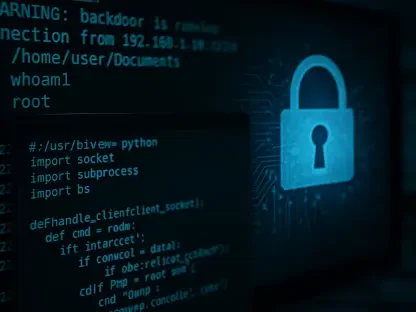In a chilling development for the cybersecurity community, a China-based threat group identified as Storm-2603 has been discovered exploiting Velociraptor, an open-source digital forensics and incident response (DFIR) tool, to orchestrate devastating ransomware attacks. Originally designed to aid security professionals in monitoring endpoints and investigating breaches, Velociraptor is now being turned against its intended purpose by malicious actors seeking to cloak their activities and secure persistent access within targeted networks. This alarming trend not only highlights the ingenuity of cybercriminals in repurposing legitimate tools but also underscores the growing challenge of detecting and mitigating such sophisticated threats. Storm-2603’s actions, which involve deploying destructive ransomware strains like Warlock, LockBit, and Babuk on critical systems such as VMware ESXi servers, serve as a stark warning of the dual-use potential inherent in many cybersecurity resources. As attackers adapt and evolve, the need for robust, proactive defense strategies becomes ever more urgent.
Unpacking Storm-2603’s Sophisticated Methods
Storm-2603 has demonstrated a remarkable level of cunning in its approach to breaching and maintaining control over compromised networks. Initially gaining notoriety for exploiting vulnerabilities in SharePoint through a campaign known as “ToolShell,” the group has since shifted to leveraging Velociraptor for enhanced stealth and effectiveness. By installing an outdated version of this DFIR tool, which contains a known privilege escalation flaw tracked as CVE-2025-6264, the attackers can execute arbitrary commands with elevated permissions. This capability allows them to move laterally across networks, blending their malicious actions with routine system operations. The use of such a legitimate tool complicates detection efforts, as its presence often appears benign to standard security scans, enabling the group to establish a foothold while preparing for the next phase of their assault.
Beyond initial access, Storm-2603 employs Velociraptor to create secure tunnels to command and control (C2) servers, facilitating ongoing communication with their infrastructure. This tactic ensures that instructions and additional payloads can be delivered without raising suspicion, as the traffic mimics expected administrative behavior. Reports from cybersecurity researchers indicate that this method has been pivotal in deploying multiple ransomware variants, targeting critical infrastructure like VMware ESXi servers with devastating effect. The resulting disruptions have caused significant operational downtime for victims, highlighting the severe consequences of these attacks. As Storm-2603 refines its techniques, the ability to disguise malicious intent within trusted tools poses a formidable challenge for defenders striving to protect sensitive environments.
Rising Trend of Exploiting Legitimate Software
A broader and deeply concerning pattern in the ransomware ecosystem is the increasing reliance on “living off the land” tactics, where attackers use legitimate software to carry out their schemes. Storm-2603’s weaponization of Velociraptor exemplifies this shift, as threat actors move away from custom-built malware that can be easily flagged by antivirus solutions. Instead, by harnessing tools originally designed for defensive purposes, these groups minimize the risk of detection, since their activities often appear as normal system processes. Insights from Cisco Talos and Sophos Counter Threat Unit (CTU) emphasize that this approach is becoming a hallmark of sophisticated ransomware campaigns, making it imperative for security teams to rethink traditional threat identification methods.
This trend of tool misuse extends beyond a single incident or group, reflecting a strategic evolution among cybercriminals globally. The appeal of repurposing trusted applications lies in their widespread acceptance and integration into corporate environments, which reduces the likelihood of suspicion. For instance, Velociraptor’s role as a respected DFIR tool means its presence on a network is rarely questioned, granting attackers a significant advantage. The implications are profound, as security solutions that focus on identifying malicious code may overlook activities conducted through legitimate channels. As this tactic gains traction, it becomes clear that defending against such threats requires a shift toward behavioral analysis and anomaly detection to uncover hidden malicious intent within seemingly innocuous operations.
Challenges in Detecting Misused Tools
Identifying the misuse of tools like Velociraptor presents a significant hurdle for cybersecurity professionals, primarily because their deployment often mimics legitimate administrative activity. Attackers exploit this ambiguity to download additional utilities, such as Visual Studio Code, and establish connections to C2 servers, all while operating under the guise of routine system management. Research from Sophos and Cisco Talos has revealed specific instances where these actions triggered alerts on advanced platforms like Secureworks’ Taegis, but only after the malicious behavior had already begun. This delay in recognition underscores the difficulty of distinguishing between authorized and unauthorized use of such tools, especially in complex enterprise environments with numerous legitimate processes running concurrently.
In response to these challenges, industry players are taking decisive steps to bolster detection capabilities. Rapid7, the current steward of Velociraptor, has introduced mechanisms to identify misuse, noting that malicious versions of the tool are frequently unsigned or bear signatures from unrecognized entities—a critical indicator of tampering. Guidance provided to organizations includes monitoring for unusual services or scheduled tasks associated with Velociraptor, as these can signal unauthorized activity. While these measures offer a starting point, the stealthy nature of such attacks means that security teams must remain vigilant and adapt quickly to evolving tactics. The emphasis on endpoint monitoring and log analysis is proving essential in uncovering subtle signs of compromise before significant damage occurs.
Adapting to Rapidly Changing Threat Landscapes
The agility of Storm-2603 in adjusting its strategies adds another layer of complexity to the cybersecurity battle. Following public disclosures about their use of Velociraptor, the group swiftly transitioned to new C2 domains hosted on services like Cloudflare’s workers.dev, demonstrating their ability to evade scrutiny with remarkable speed. This rapid adaptation suggests a high level of operational awareness and a willingness to pivot whenever their methods are exposed. Although detections of Velociraptor misuse reportedly declined by mid-September, this could indicate either a tactical shift to other tools or the effectiveness of enhanced defensive measures. Regardless, it illustrates the ongoing cat-and-mouse dynamic between attackers and defenders in the digital realm.
Such adaptability necessitates a forward-thinking approach from organizations aiming to stay ahead of threats. The evolving nature of ransomware campaigns, as seen with Storm-2603, highlights the importance of continuous intelligence gathering and sharing within the cybersecurity community. Collaborative efforts among researchers and vendors have already yielded valuable insights into attack patterns, enabling faster identification of new techniques. However, the persistent innovation displayed by threat actors means that static defenses are insufficient. Security teams must prioritize dynamic strategies that anticipate potential misuse of legitimate tools, integrating real-time threat intelligence to respond effectively to emerging risks and prevent breaches before they escalate.
Building Stronger Defenses Against Emerging Risks
The ramifications of Storm-2603’s tactics are a clear call to action for organizations to move beyond reliance on conventional security tools and patching routines. Experts advocate for a comprehensive, multi-layered defense strategy that incorporates behavioral detection to identify unusual patterns of activity, even when conducted through trusted software. Regular audits of software deployments within network environments are also critical, ensuring that unauthorized instances of tools like Velociraptor are flagged and investigated promptly. By implementing strict controls on executable binaries, companies can limit the potential for malicious code to run undetected, reducing the attack surface available to sophisticated groups exploiting legitimate resources.
Further strengthening defenses requires a focus on endpoint monitoring and detailed log analysis to uncover subtle indicators of compromise. Suspicious activities tied to processes like “velociraptor.exe” must be scrutinized, as they could reveal hidden threats lurking within systems. Guidance from Rapid7 emphasizes the importance of identifying Indicators of Compromise (IoCs), such as unsigned binaries or unexpected network connections, as actionable steps for security teams. Adopting these practices not only helps mitigate the immediate risks posed by groups like Storm-2603 but also prepares organizations for future threats that leverage the dual-use nature of cybersecurity tools. Proactive measures, grounded in vigilance and adaptability, are essential to safeguarding critical infrastructure in an increasingly hostile digital landscape.









